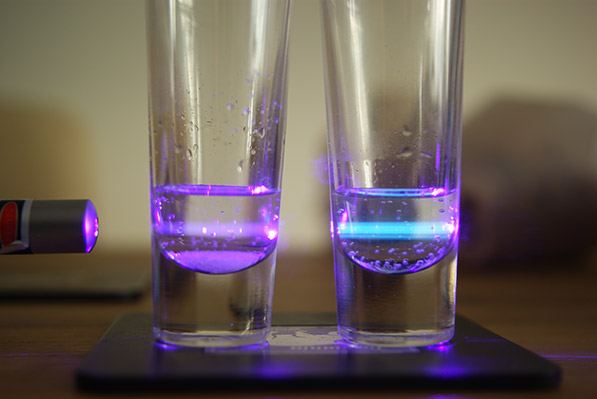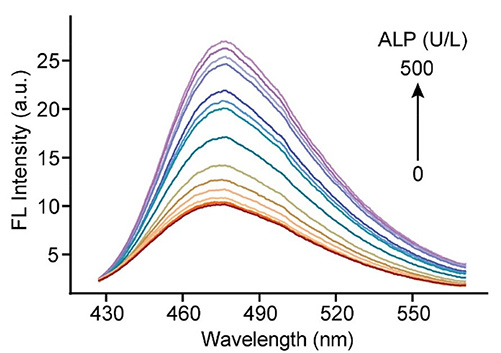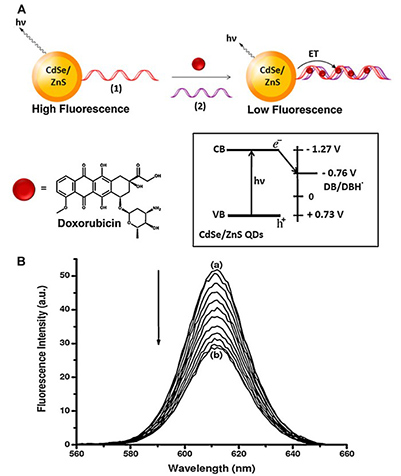Electron Transfer Quenching Platform
Background

Figure 1. Quenching of quinine fluorescence by chloride ions.
Quenching refers to a process in which the fluorescence of a substance is reduced due to interactions with another molecule. This typically occurs when the excited state of a fluorophore is prematurely deactivated—returning to the ground state without emitting a photon—resulting in a measurable loss of fluorescence. This principle is foundational to many optical sensing technologies. For example, the quenching effect of oxygen on ruthenium complexes is widely used to measure oxygen saturation in optode-based systems.
Building on this well-established concept, our Electron Transfer Quenching (ETQ) Platform is a next-generation technology designed to detect biochemical activity via redox-sensitive fluorescence changes. It utilizes controlled electron transfer between a fluorophore and quencher to monitor molecular events in real time, delivering exceptional sensitivity and a broad dynamic range for both enzymatic and cellular assays.
At the heart of the ETQ platform is a fluorophore-quencher probe system. In its unmodified state, fluorescence is quenched through electron transfer. Upon enzymatic activity—such as cleavage, oxidation, or reduction—this quenching is disrupted, resulting in a quantifiable fluorescence signal. The change directly correlates with the biological activity under investigation, providing a powerful readout for a wide range of research and screening applications.
At Creative BioMart, our ETQ platform offers a sensitive, fluorescence-based solution for accurately measuring the activity of kinases, phosphatases, proteases, and phosphodiesterases—all with a single, streamlined assay system.
What We Offer?
Applications and Substrate Compatibility
| Application Area | Description | Compatible Substrates |
|---|---|---|
|
Measure phosphorylation events by detecting disruption of fluorescence quenching. |
Peptides, cyclic nucleotides, oligonucleotides |
|
|
Phosphatase Activity Assays |
Detect dephosphorylation via real-time fluorescence changes. |
Peptides, phospho-oligonucleotides |
|
Monitor peptide cleavage events with high sensitivity. |
Peptides, protein fragments |
|
|
Phosphodiesterase Activity |
Quantify hydrolysis of cyclic nucleotides or oligonucleotides. |
cAMP, cGMP, cyclic dinucleotides |
|
Multiplex Enzyme Profiling |
Uniform detection approach enables high-throughput, parallel enzyme analysis. |
Mixed panels of labeled peptides & nucleotides |
|
Real-Time Kinetic Studies |
Continuous monitoring of reaction progress with high temporal resolution. |
Any fluorophore-labeled substrate |
|
Scalable for drug screening and compound profiling in enzymatic assays. |
Custom fluorophore-tagged substrate libraries |
Sensor Compatibility
- Fluorophores Supported: Any spectral property (e.g., FITC, Cy5, Alexa Fluor series)
- Detection System: Fluorescence spectrophotometer
- Assay Format: Homogeneous, no-wash format for streamlined workflow
Why Choose Us?
- High-Throughput Screening: Easily scaled for 96- or 384-well formats, ideal for rapid compound screening and drug discovery workflows.
- Physiological Relevance: Supports assays at native substrate and ATP concentrations to mimic in vivo conditions and improve biological accuracy.
- Standard Instrumentation: Compatible with any standard fluorescence spectrophotometer—no need for specialized or proprietary detection systems.
- No Spectral Overlap Issues: Fluorophores don’t require spectral separation, enabling simpler assay design and more flexible probe choices.
- Broad Enzyme Compatibility: Effective for a wide range of enzymes including kinases, phosphatases, phosphodiesterases, proteases, and lipid-processing enzymes.
- Multiplex Capability: Multiple enzyme activities can be measured in parallel using distinct fluorophores—perfect for pathway analysis or screening panels.
- No Radioactivity or Costly Antibodies: Eliminates the need for radiolabels or expensive immunoreagents, reducing cost and simplifying regulatory compliance.
- Linear, Quantifiable Response: Delivers consistent, dose-dependent signal output for precise enzyme kinetics and inhibitor profiling.
- Stable, Reproducible Detection: Reagents are highly stable with no lot-to-lot variation, ensuring reliable results across experiments and batches.
Case Study
* NOTE: We prioritize confidentiality to safeguard our clients’ technology and intellectual property. As an alternative, we present selected published research articles as representative case studies. For details on the assay services and products used in these studies, please refer to the relevant sections of the cited literature.
Case 1: Synergistic quenching-based ALP biosensor using fluorescent Si dots
Mao et al., 2023. doi:10.1016/j.aca.2023.341510
A novel biosensor platform was developed using cyan-emitting silicon (Si) dots to detect alkaline phosphatase (ALP) through a synergistic quenching mechanism involving the inner filter effect (IFE) and photo-induced electron transfer (PET). These Si dots, synthesized via a microwave-assisted method, exhibit high quantum yield and excellent stability. In the presence of ALP, the hydrolysis product of 4-nitrophenyl phosphate quenches Si dot fluorescence, enabling sensitive, turn-off mode detection. The biosensor offers dual linear detection ranges (0.05–5.0 U/L and 5.0–80.0 U/L) with a low detection limit of 0.01 U/L, and performs reliably in complex matrices like human serum, making it promising for clinical diagnostics.

Figure 2. Fluorescence spectra of Si dots responding to different concentrations of ALP in turn-on mode with excitation wavelength of 302 nm. (Mao et al., 2023)
Case 2: Electron-transfer quenching of nucleic acid-functionalized CdSe/ZnS quantum dots by doxorubicin
Raichlin et al., 2011. doi:10.1016/j.bios.2011.05.016
This study presents a versatile electron transfer quenching platform using CdSe/ZnS quantum dots (QDs) for biosensing DNA, small molecules, and telomerase activity. Aptamers or DNA strands form duplexes or complexes on the QDs, which bind doxorubicin (DB). DB intercalates into the DNA structures and quenches the QD luminescence, providing a measurable signal. This strategy is applied to detect targets like cocaine, thrombin, and telomerase—a key cancer biomarker—through DB-mediated quenching. The method enables sensitive, optical-based biosensing and shows promise for rapid cancer diagnostics and other molecular detection applications.

Figure 3. Graphic abstract for the study: universal glycosyltransferase continuous assay for uniform kinetics and inhibition database development and mechanistic studies illustrated on ST3GAL1, C1GALT1, and FUT1. (Nashed and Naidoo, 2024)
Customer Testimonials
-
"The Creative BioMart’s electron transfer quenching platform has revolutionized our kinase activity assays. The single-sensor design enables real-time, direct quantification of phosphorylation events with impressive precision. Its compatibility with a wide range of fluorogenic substrates has expanded the scope of our experiments significantly. We’ve found it especially useful in multiplexed formats for high-throughput screening."
— Principal Investigator | Academic Medical Center
-
"Our research group has integrated the Creative BioMart’s electron transfer quenching platform into several enzymatic profiling projects. Its capacity to simultaneously monitor multiple enzyme classes—including kinases, phosphatases, and proteases—has proven invaluable in early-stage drug discovery. The high-sensitivity spectrophotometric readout and streamlined assay setup have improved both reproducibility and throughput."
— Lead Scientist | Biotechnology Company
-
"This platform has become central to our phosphodiesterase inhibition studies. Its unified detection system minimizes variability across assays and has facilitated more consistent SAR (structure-activity relationship) data. The system’s substrate flexibility has allowed us to test both cyclic nucleotide and non-nucleotide analogs with ease."
— Research Scientist | Pharmaceutical Company
-
"We’ve employed the electron transfer quenching platform from Creative BioMart extensively in our protease inhibitor screens. The precision of the single-sensor detection and its compatibility with peptide- and small-molecule-based substrates has enabled us to refine our lead optimization pipeline. Its efficiency in high-throughput conditions has significantly reduced assay time."
— Senior Scientist | Biotechnology Company
-
"The platform simplifies the quantification of both kinase and phosphatase activities using a single, integrated sensor system. Its performance across various substrate classes has made it a mainstay in our lab. Particularly in dual-enzyme cascade studies, the ability to rapidly switch substrates without recalibration has streamlined our workflow."
— Research Director | Research Institution
FAQs
-
Q: What is the electron transfer quenching platform, and how does it differ from traditional fluorescence-based assays?
A: Our electron transfer quenching platform is an advanced fluorescence-based assay system designed to measure and quantify the activities of various enzymes, including kinases, phosphatases, proteases, and phosphodiesterases. Unlike traditional fluorescence assays that often require multiple sensors or complex setups, our platform uses a single, unified sensor to directly measure enzyme activities. This simplifies the experimental process while providing high precision and accuracy. -
Q: What are the key advantages of the electron transfer quenching platform?
A: Our platform offers several key advantages:- Unified Detection: Measures multiple enzyme activities using a single sensor, reducing complexity and the need for multiple detection systems.
- Direct Quantification: Provides real-time, quantitative data on enzyme activities, ensuring accurate and reliable results.
- Versatile Substrate Compatibility: Works with a wide range of substrates, including lipids, oligonucleotides, cyclic nucleotides, and peptides, all of which can be labeled with fluorophores of any spectral property.
- High Precision: Utilizes a fluorescence spectrophotometer to measure photon intensity with high accuracy.
- Customizable Solutions: Allows researchers to tailor their experiments to specific needs, enhancing flexibility and adaptability.
-
Q: Can I use this platform for different types of enzymes?
A: Yes, our electron transfer quenching platform is designed to be highly versatile. It can measure and quantify the activities of various enzymes, including:- Kinases: Enzymes that phosphorylate proteins or other molecules.
- Phosphatases: Enzymes that remove phosphate groups from molecules.
- Proteases: Enzymes that break down proteins.
- Phosphodiesterases: Enzymes that hydrolyze phosphodiester bonds in molecules like cyclic nucleotides.
-
Q: What substrates are compatible with the electron transfer quenching platform?
A: Our platform is compatible with a broad range of substrates, including:- Lipids
- Oligonucleotides
- Cyclic Nucleotides
- Peptides
-
Q: How does the fluorescence spectrophotometer contribute to the accuracy of the platform?
A: The fluorescence spectrophotometer is a critical component of our electron transfer quenching platform. It measures the intensity of emitted photons with high precision, providing accurate and reliable data on enzyme activities. This high-precision measurement ensures that even subtle changes in enzyme activity can be detected, making our platform ideal for both basic research and drug discovery applications. -
Q: Can I customize the assays to fit my specific research needs?
A: Absolutely! One of the key advantages of our electron transfer quenching platform is its flexibility. Researchers can customize their assays by selecting specific substrates and fluorophores based on their research goals. This customization ensures that the platform can be adapted to a wide range of applications, from studying enzyme mechanisms to screening potential drug candidates. -
Q: What kind of support do you offer for users of the electron transfer quenching platform?
A: Creative BioMart is committed to providing comprehensive support to our customers. Our team of experienced scientists is available to assist with:- Assay Design: Helping you select the optimal substrates and fluorophores for your specific research needs.
- Data Interpretation: Providing guidance on how to interpret your results and troubleshoot any issues.
- Technical Support: Offering ongoing support to ensure that you get the most out of our platform.
-
Q: Is the electron transfer quenching platform suitable for high-throughput screening?
A: Yes, our platform is well-suited for high-throughput screening applications. Its unified detection system and broad substrate compatibility allow for efficient and accurate measurement of enzyme activities across multiple samples. This makes it an ideal choice for large-scale research projects and drug discovery efforts.
Resources
Related Services
- Enzyme Activity Assay
- Protease Assay Service
- Protein Kinase Assay
- Multiplex Protein Detect Assay
- High-Throughput Screening
- Universal UDP-Glycosyltransferase Assay
- Enzyme Target and Screening
Related Products
References:
- Mao G, Qiu C, Luo X, et al. Synergistic effect-triggered fluorescence quenching enables rapid and sensitive detection of alkaline phosphatase. Analytica Chimica Acta. 2023;1272:341510. doi:10.1016/j.aca.2023.341510
- Raichlin S, Sharon E, Freeman R, Tzfati Y, Willner I. Electron-transfer quenching of nucleic acid-functionalized CdSe/ZnS quantum dots by doxorubicin: A versatile system for the optical detection of DNA, aptamer–substrate complexes and telomerase activity. Biosensors and Bioelectronics. 2011;26(12):4681-4689. doi:10.1016/j.bios.2011.05.016
Contact us or send an email at for project quotations and more detailed information.
Quick Links
-

Papers’ PMID to Obtain Coupon
Submit Now -

Refer Friends & New Lab Start-up Promotions

